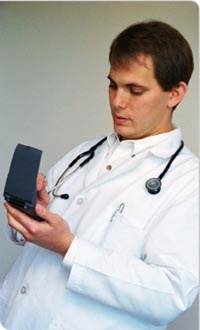 I woke up this morning with a pretty big sty on my eye; I could feel it coming on last night. Big, puffy, and sore : I couldn’t get my contact lenses in, which is kind of a drag since I do a talk for SAP today (Theme: Velocity, Agility, Complexity and Flexibility: The Four Key Drivers for Competitive Advantage: more on that to come.)
I woke up this morning with a pretty big sty on my eye; I could feel it coming on last night. Big, puffy, and sore : I couldn’t get my contact lenses in, which is kind of a drag since I do a talk for SAP today (Theme: Velocity, Agility, Complexity and Flexibility: The Four Key Drivers for Competitive Advantage: more on that to come.)
At 6:45am this morning, I went down to the home office, and e-mailed my eye doctor asking what I should do. At 6:47AM, he emailed me back with a few suggestions, and advised me to come in at 9:30am. Talk about customer service!
My eye-doc is a bit younger than me — and he’s grown up with technology. In terms of his medical practice, he has always been at the leading edge of the curve in terms of adoption of new equipment and technology. He has had quite a consultative approach with me through the years, taking a cumulative series of hi-resolution digital pictures of my retina for example, in order to be able to show me the slow and steady (and normal) impact of aging. (And, in effect, helping me get over the fact that I increasingly need to use reading glasses.)
So it is with his rapid response on e-mail; he commented in our exchange this morning that “instead of a Blackberry, I use an ultraportable Thinkpad. Wireless at home, wireless at work, wireless at Starbucks — the 3 places where I live 95% of my life. 🙂”
As a medical professional, he’s wired up, interactive, and providing a different type of medical service. To him, interactivity with the patient is a good thing, and all part of the service. That’s innovation right there.
The 21st century medical professional is:
- collaborative: the patient is a partner in the process: they know we are empowered with information, and they work with us to help us understand how to best use it given our medical circumstance
- responsive: yes, they have a life. They use technology to balance how they spend their professional and personal time, and in doing so, provide rapid customer service.
- interactive: the online world plays a key role in the service element; from e-mail appointments to a prescription that includes an online information source
- progressive: there’s a flood of new ideas and methodologies coming into the world of medicine. They adopt it, understand it, and utlize it to improve health care delivery
I wrote about this trend with my Future Medicine: Prescriptions for 21st Century Health Care overview, noting that one of the 10 biggest trends to impact health care in the future will be the impact of such interactivity on medical delivery: “ The entire medical system is set to be transformed with the entrance of GenConnect (those born after 1990) into the health care system. As they take on careers as medical professionals and administrators, they will bring with them a flood of new ideas, innovation and different ways of thinking. Health care institutions currently clogged with organizational sclerosis cannot keep pace with today’s demands. But GenConnect’s aggressive attitude towards change will quickly break down this sclerosis.”
As the Gen-Connect generation — the ultimately wired crowd — gets involved in health care delivery, we are going to witness a massive and significant transformation of the system. And that can only be a good thing!
Read Future Medicine: Prescriptions for 21st Century Health Care
EyeDoc: Port Credit Optometrists and Dr. Peter Rozanec




GET IN TOUCH
Jim's Facebook page
You'll find Jim's latest videos on Youtube
Mastodon. What's on Jim's mind? Check his feed!
LinkedIn - reach out to Jim for a professional connection!
Flickr! Get inspired! A massive archive of all of Jim's daily inspirational quotes!
Instagram - the home for Jim's motivational mind!